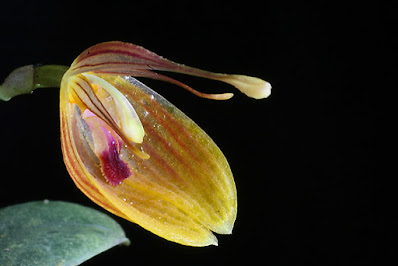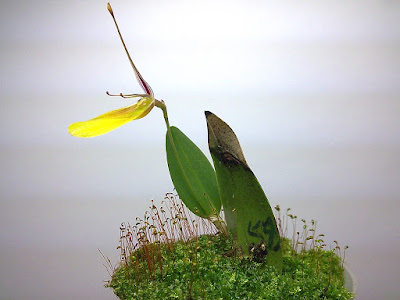Restrepia have been well known to orchid growers for many years due to their distinctive floral morphology...
Restrepia is a genus of the Orchidaceae family. This genus was described by Carl Sigismund Kunth in 1816 and was named in honor of Don Jose Restrepo. These species have been well known to orchid growers for many years due to their distinctive floral morphology and the relative ease with which the more common species may be cultivated.
IDENTIFY RESTREPIA ORCHID
Restrepia species are found throughout Central America and in Venezuela, Colombia, Ecuador, Peru and Bolivia in South America at elevations of 1800 to 2400 meters. They have their centre of distribution in the high Andes of Colombia and Ecuador and are to be found growing epiphytically in cool, wet conditions in the Andean montane forests, in open spots with high light near rivers and streams on tree trunks and lower branches and can become quite a large mass. They are often found in association with other Pleurothallids but are less common.
The plants in this genus are small or tiny sized epiphytic or rarely lithophytic herbs that lack of pseudobulbs with short stems or ramicauls that have elliptic-ovate, erect, thick, leathery leaf.
These species can blooms over and over for years from one to several, terminal, single flowered inflorescence. The long dorsal sepal is erect and ends in a somewhat thicker club-shaped tip. They have fused lateral sepals which may be quite colorful : white, yellow, rose, purple, orange or tan with red, brown or purple overlaid frequently with contrasting reddish-purple spots or stripes. The long, lateral petals equally end in a thickened club-shaped tip. The long lip is ovoid and widest its apex. It shows the same variations in color and markings.
RESTREPIA CARE AND CULTURE
Cultural information should only be used as a guide, and should be to be adapted to suit you. Your physical location; where you grow your plants, how much time you have to devote to their care, and many other factors, will need to be taken into account. Only then can you decide on the cultural methods that best suit you and your plants.
Light:
Restrepia needs a light level of 18000-25000 lux. The light should be somewhat filtered or diffused and the plants should not be exposed to direct sunlight during midday hours. This species grow well under artificial light.
Temperature:
Although they prefer the cold greenhouse, most Restrepia species are very tolerant of growing conditions. If the compost remains wet, they can withstand temperatures above 35 °C. There is simply a slowdown in growth and flowering when the temperatures are too high. Ideal temperatures are between 10 and 18 ° C at night and 18 to 26 ° C during the day.
Humidity:
Restrepia needs a humidity level of greater than 60% for potted plants, close to 80% for mounted plants. Too dry air has a negative effect on the development of the plant: its growth is inhibited, and the leaves begin to turn yellow and dry out. The higher temperature, the higher the humidity should be, and the higher the humidity, the more often and longer it is necessary to ventilate the room where the plants are contained, otherwise the probability of rotting and various kinds of fungal diseases.
Substrate and growing media:
Restrepia species can be grown in pots with a good draining substrate of pine bark and chopped sphagnum moss, to which we can add perlite, charcoal, polyurethane foam or polystyrene fragments in small quantities. The plants can also be grown in pure sphagnum moss, rock wool, mounted on cork, tree fern. When mounted, care should be taken to maintain good humidity.
Repot every 2 years, in late winter or early spring. These plants do not tolerate decomposed substrate and should be repotted as soon as the substrate begins to decompose or as they outgrow their pots. If we transplant when new roots begin to emerge, the plant will take root in the shortest possible time.
Under good growing conditions, the clumps of Restrepia double in size every year. We can then divide them by cutting the tuft. Many species also produce seedlings or keikis, that it is possible, when sufficiently developed, to separate from the mother plant. It is also possible to make leaf cuttings . It is then necessary to take a leaf that has already flowered, with part of its branch, and half-bury it in compost kept constantly moist (cover the pot with plastic food wrap). A few months later, small leaves appear. The result is a plant capable of flowering in 1 to 2 years.
Watering:
Restrepia love humidity, their roots never have to dry out completely. In nature they have a continuous vegetative cycle, so we wet them regularly all year round to keep the substrate moist but we must avoid stagnation of water because they cause rot at the roots.
Watering is directly dependent on the temperature of the content, the higher it is, the more often it needs to be watered. Plants growing on blocks or with a bare root system, preferably watered daily in the morning, so that in the evening their roots can dry out relatively well. During the summer heat, additional spraying is possible. When watering, excess water should flow freely from the pot, since stagnation of water both inside the pot and in its pan can very quickly lead to rotting of the roots and the lower part of the plant.
Fertilizer:
During the period of active growth, plants should be fertilized every week 1 / 4-1 / 2 of the recommended dose of fertilizer for orchids. Many growers prefer to use a balanced fertilizer all year round, but there are those who use a fertilizer with increased nitrogen content from spring to mid-summer and then, in late summer and fall, start using fertilizer with a higher phosphorus content.
Rest period:
The cultivation conditions should be maintained throughout the year. In winter, the amount of water can be reduced somewhat, especially if the plants are grown under the dark, short-day conditions that occur in temperate latitudes. However, they must never be allowed to dry completely. If plant watering is limited, fertilization should also be reduced.
BUY RESTREPIA AND RELATED PRODUCTS
BUY ANOTHERS SPECIES AND VARIETIES OF RESTREPIA GENUS HERE!
















COMMENTS